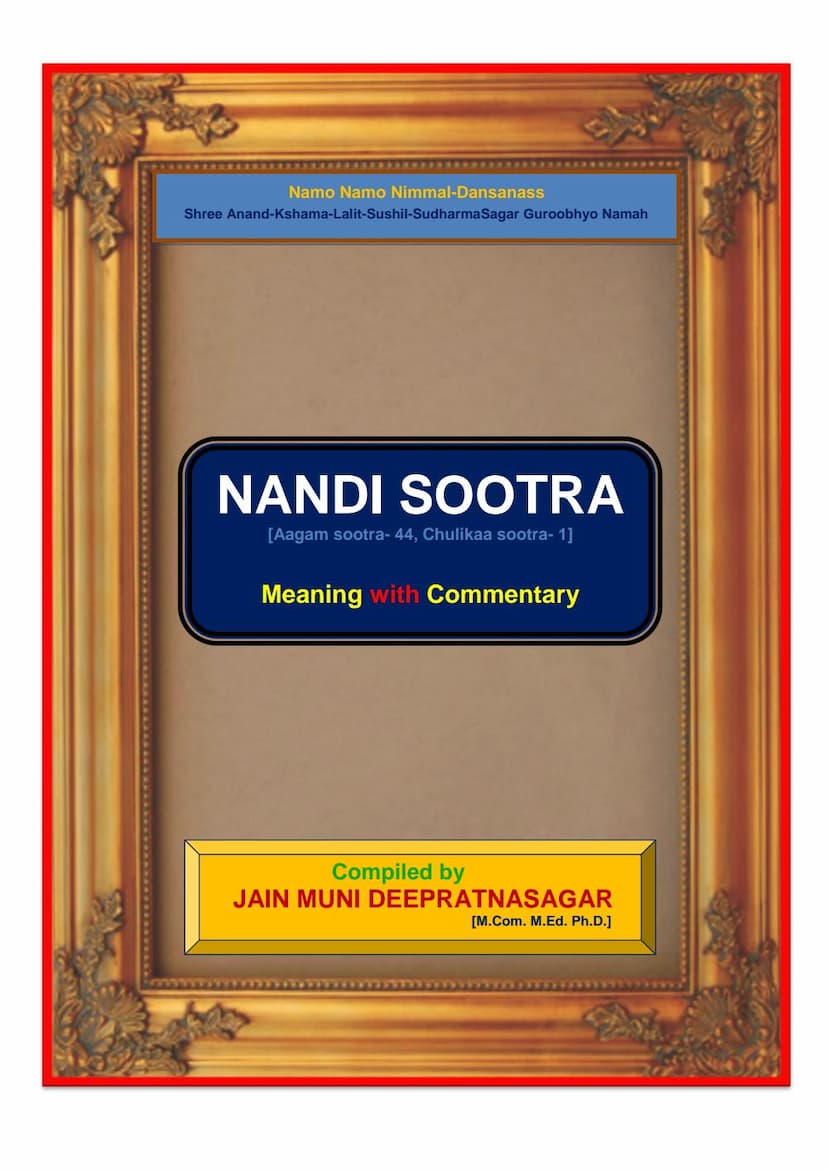Agam 44 Chulika 01 Nandi Sutra English Translation
Added to library: September 1, 2025

Summary
This English translation and commentary of Nandi Sutra, compiled by Muni Deepratnasagar, is an accessible introduction to a key Jain text. Nandi Sutra, also known as Chulika Sutra-1, is considered auspicious and focuses on the theme of knowledge, particularly the five types of Jain "Jnana" (knowledge).
The text begins with invocations and praises to the Arhats, Lord Mahavir, and the Jain Sangh, highlighting their virtues and significance. The compilation then delves into detailed explanations and metaphors for the Sangh, comparing it to a wheel, chariot, lotus, moon, sun, sea, and mountain, illustrating its strength, purity, and spiritual depth.
A significant portion of the Nandi Sutra is dedicated to outlining the lineage of Jain Acharyas (spiritual leaders) from the time of Lord Mahavir. It meticulously lists and describes the contributions and periods of these influential figures, tracing the transmission of Jain knowledge through successive generations.
The sutra then meticulously categorizes and defines different types of knowledge (Jnana) and listeners:
Types of Knowledge (Jnana): The text elaborates on the five types of knowledge:
- Abhinibodhik-jnana (Mati-jnana): Sensory knowledge gained through the five senses and mind.
- Shrut-jnana: Knowledge acquired through listening or study of scriptures.
- Avadhi-jnana: Extra-sensory perception of physical phenomena.
- Manah-paryava-jnana: Knowledge of the thoughts and feelings of others' minds.
- Keval-jnana: Omniscience, the ultimate and complete knowledge.
It further breaks down knowledge into direct (Pratyaksh) and indirect (Paroksh) categories, detailing the various types and their classifications, including discussions on Avadhi-jnana, Manah-paryava-jnana, and Kewal-jnana, with extensive explanations on their scope, attributes, and conditions for attainment.
Types of Listeners: The Nandi Sutra classifies listeners into fourteen types, using vivid analogies of animals and objects to illustrate their receptivity and approach to knowledge. These range from the completely unreceptive (like a smooth rock) to the highly discerning (like a swan).
Types of Congregations: The text also identifies three types of congregations (assemblies for listening to religious discourses):
- Jnayika: Virtuous listeners who appreciate virtues and reject vices.
- Ajnayika: Immature and impressionable listeners who can be guided.
- Durvidagdha: Conceited and shallow listeners who resist learning.
The Twelve Angas (Canon): A substantial part of the commentary provides a detailed overview of the twelve principal Jain scriptures (Angas), including:
- Acharang Sutra: Focuses on the conduct and discipline of ascetics.
- Sutrakritang Sutra: Refutes non-Jain philosophies and establishes Jain principles.
- Sthanang Sutra: Systematically categorizes Jain principles and entities.
- Samvayang Sutra: Substantiates Jain principles through numerical categorization.
- Vyakhyaprajnapti (Bhagavati Sutra): A voluminous text with extensive philosophical and practical discussions.
- Jnatadharmakatha Sutra: Narrates religious tales and exemplary lives.
- Upasakadashang Sutra: Details the lives of ten prominent lay followers (Shravaks).
- Antakriddashang Sutra: Describes the lives of ascetics who achieved liberation in their last birth.
- Anuttaraupapatikdasha Sutra: Focuses on souls reincarnated in the highest celestial realms.
- Prashnavyakaran Sutra: Discusses questions and answers related to auspicious and inauspicious omens, and miraculous powers.
- Vipak Shrut: Explains the consequences (fruits) of good and bad deeds.
- Drishtivad: The eleventh Anga, considered a comprehensive encyclopedia of philosophies, considered lost but its structure and divisions are outlined.
The text emphasizes the importance of Samyak Shrut (right scriptural knowledge) and contrasts it with Mithya Shrut (wrong scriptural knowledge). It also defines Gamik (canonical) and Agamik (non-canonical) scriptures, and further categorizes them into Angapravishta (part of the canon) and Angabahya (outside the canon), including essential daily practices like Avashyak.
The compilation highlights various types of wisdom (Buddhi) – Autpattiki (spontaneous), Vainayiki (humble), Karmaja (practical), and Parinamiki (deductive) – illustrated with numerous illustrative stories. These stories demonstrate how wisdom, humility, practice, and reasoning lead to success, good fortune, and spiritual advancement.
Finally, the Nandi Sutra concludes by reaffirming the eternality of the Dvadashang Ganipitak (the twelve Angas) and outlining the types and procedures for studying Shrut-jnana, emphasizing the importance of qualities like listening attentively, questioning, contemplation, and ultimately, right conduct.
This work serves as a valuable resource for understanding the foundational concepts of Jainism related to knowledge, its transmission, and its proper application.